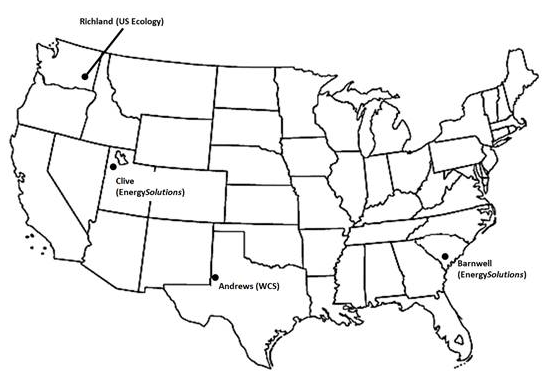
four locations have been authorized to store low level radioactive wastes
Source: US Nuclear Regulatory Commission, Locations of Low-Level Waste Disposal Facilities

four locations have been authorized to store low level radioactive wastes
Source: US Nuclear Regulatory Commission, Locations of Low-Level Waste Disposal Facilities
Low-level radioactive waste is hazardous, but emits less radiation than transuranic wastes produced at atomic weapons sites or high-level wastes generated in reactors at nuclear power plants. Typically:1
Low-level radioactive wastes are classified into three categories. Class A is the lowest level, with radioactivity dropping to background levels within 100 years. Class B and Class C wastes emit higher levels of radiation and must be handled with greater care for up to 500 years. Wastes emitting radiation at levels greater than Class C (some of which is produced at BWXT in Lynchburg) must be placed in a geologic repository as transuranic or high-level radioactive waste:2

x-ray machines in dental offices produce low-level radioactive waste
Source: Bureau of Labor Statistics, Dental Assistants, US National Library of Medicine, Profile of chronic and aggressive periodontitis among Senegalese
In the Low-Level Radioactive Waste Policy Act of 1980, the US Congress defined low-level radioactive waste disposal to be a state responsibility. Congress encouraged the states to negotiate interstate compacts and establish several regional disposal sites for low-level radioactive waste disposal. Congressional approval of interstate compacts for regional partnerships, with the ability to exclude low-level radioactive waste generated outside the boundaries of the partnerships, began in 1986.
Each state was required to search for a suitable disposal site for low-level radioactive waste, knowing that few places wanted radioactive waste in their neighborhood. The political impacts of the decision would be a problem for the host state, and Congress structured the program so the states negotiated directly with each other.
In 1984 Virginia joined the Southeast Interstate Low-Level Radioactive Waste Management Compact, together with Alabama, Florida, Georgia, Mississippi, and Tennessee, North Carolina, and South Carolina. That compact received Congressional approval in 1986.
At the time, Virginia shipped its Class A, B, and C radioactive waste to Barnwell, South Carolina. It was one of only a handful of facilities nationwide that accepted low-level radioactive waste.
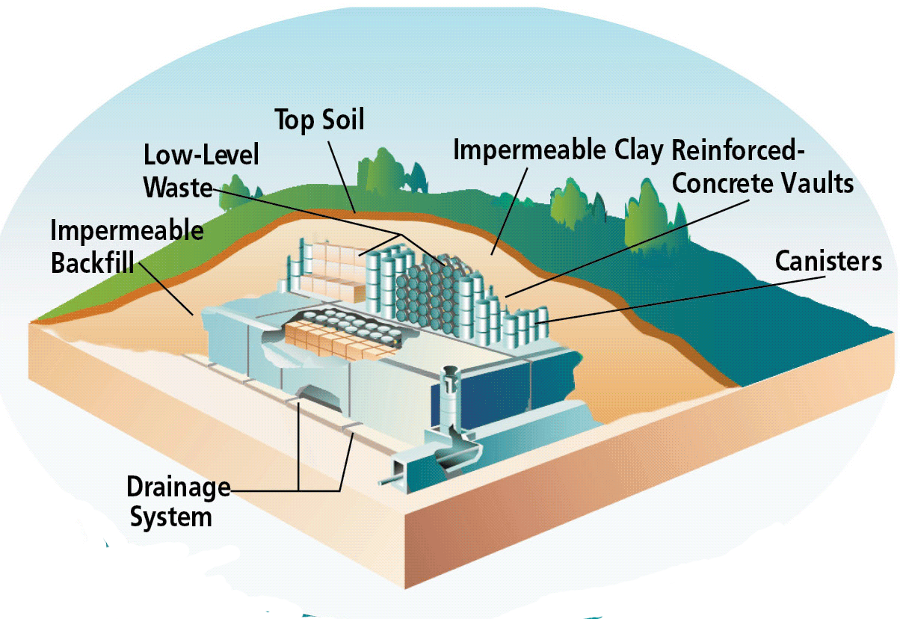
drums and other storage containers filled with low level radioactive waste are buried in dirt-covered landfills
Source: Nuclear Regulatory Commission, Low-Level Waste
Under the terms of the compact, the South Carolina facility was projected to close in a decade. The Virginia General Assembly, when joining the compact, agreed that "in no event shall this disposal facility serve as a regional facility beyond December 31, 1992."
Members of the Southeast Interstate Low-Level Radioactive Waste Management Compact anticipated that one of the other states in the compact would open a replacement facility. South Carolina was willing to be the first of the "host" states in the Southeast Interstate Low-Level Radioactive Waste Management Compact, but did not want to get a reputation as a nuclear dumping ground.
Virginia focused its search for a suitable disposal site in the Southside region, plus Louisa County.3
Criteria for selecting the site were:4
- amount of potentially suitable area (PSA)
- volume of A/B/C waste generated
- transportation distances from low-level radioactive waste (LLRW) generators for A/B/C waste
- density of transportation systems in potentially suitable areas
- population density of potentially suitable areas
- meteorology of potentially suitable areas
The states in the compact decided in 1986 that a new low-level radioactive waste facility should be located in North Carolina in Wake County, near the Chatham County line. North Carolina officials originally supported the compact's decision.
To sweeten the deal, compact members contributed $80 million for geological and other studies of the site. The funding was raised by imposing fees on generators of low-level nuclear waste who shipped it to Barnwell. North Carolina spent an additional $30 million.5
When North Carolina's project kept missing milestones for obtaining a license and opening a new disposal site, South Carolina agreed to extend the closure date of Barnwell until 1996. In exchange, the South Carolina legislature required that significant new revenues be generated for South Carolina; fees for using Barnwell were increased.
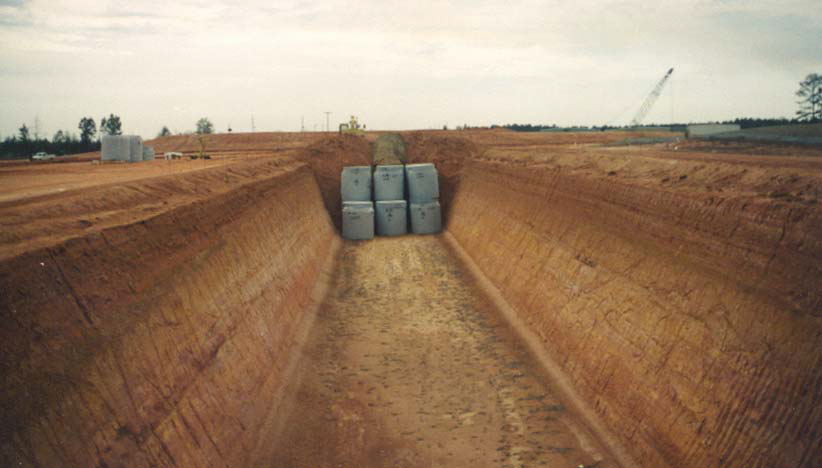
low-level radioactive waste is placed in dirt trenches
Source: Atlantic Compact Commission, Barnwell Low-Level Radioactive Waste Disposal Facility In-Region Operating Costs
South Carolina became fond of the high revenue stream, and requested that the compact allow Barnwell to accept radioactive wastes produced at states outside the compact. The other states blocked that request.6
In 1995 South Carolina withdrew from the Southeast Interstate Low-Level Radioactive Waste Management Compact. It formed the Atlantic Interstate Low-Level Radioactive Waste Management Compact with Connecticut and New Jersey.
South Carolina closed Barnwell to shipments of radioactive waste from North Carolina, but allowed generators in other states to use the facility until 2008. Today, Barnwell accepts Class A, B, and C low-level radioactive waste produced only within the boundaries of South Carolina and the other two members of the Atlantic Interstate Low-Level Radioactive Waste Management Compact (Connecticut and New Jersey).7
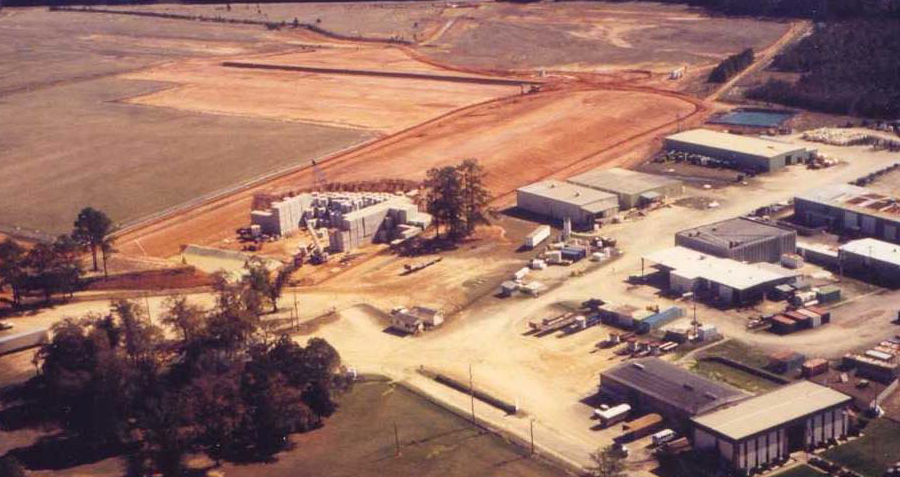
in 2008, South Carolina blocked Virginia from sending low-level radioactive waste to the Barnwell disposal site
Source: Atlantic Compact Commission, Barnwell Low-Level Radioactive Waste Disposal Facility In-Region Operating Costs
South Carolina's withdrawal blocked the remaining states from collecting new fees from waste generators. The loss of revenue meant that the other states in the Southeast Interstate Low-Level Radioactive Waste Management Compact could no longer subsidize North Carolina's effort to open the site in Wake County. After the remaining states in the Southeast Interstate Low-Level Radioactive Waste Management Compact notified North Carolina that it would have to complete the development of the new waste disposal site without additional funding, that project came to a halt.
In 1999, North Carolina withdrew from the compact. The remaining members in the compact "sanctioned" North Carolina, but the US Supreme Court ruled in 2010 that North Carolina could not be forced to repay $80 million (plus $10 million in legal fees) to the other states.8
Virginia continued to ship its low-level radioactive waste to Barnwell until 2008. A facility in Clive, Utah and another in Andrews, Texas accept Class A waste from Virginia now. The Andrews, Texas site, which opened in 2012, also has the capability to accept Class B and Class C low-level radioactive wastes.9

the Clive, Utah site now receives the majority of low-level radioactive waste produced in the United States
Source: Nuclear Regulatory Commission, Low-Level Waste Disposal Statistics
In 2009, the Nuclear Regulatory Agency signed an agreement with Virginia, granting it authority to regulate low-level radioactive waste. The Federal agency transferred nearly 400 licensees to the state and gave it authority to issue new licenses.
The Nuclear Regulatory Agency conducts regular reviews of Virginia's management, ensuring the state was in compliance with Federal regulations and used appropriately-calibrated survey instruments. In 2011, for example, the review examined how the Virginia Department of Health dealt with radioactive materials at a medical event, lost and stolen radioactive material, and damaged equipment.10
In addition to nuclear waste generated at civilian facilities such as hospitals and power plants, Huntington Ingalls and the US Navy create low-level radioactive waste during maintenance and overhaul operations in Hampton Roads. Contaminated rags, plastic bags, paper, filters, ion exchange resin, and scrap materials are collected from nuclear-powered ships and bases and shipped to the same commercial disposal sites as low-level waste from civilian sites.
About once month, a truck carries such waste away from Hampton Roads to Texas or Utah. Since Virginia has no site for disposal of low-level radioactive waste, none of the Navy-related maintenance waste which accumulates in Hampton Roads stays within the state for more than about a month.
In 2007, the US Navy scrapped the YRR-14 radiological repair barge. Built in the middle of World War II, that converted vessel had supported maintenance of nuclear-powered submarines at the Norfolk Naval Shipyard until 2002. The entire barge was dismantled at a commercial shipyard in Memphis, Tennessee. All the radioactive components were transported to a commercial disposal site.11
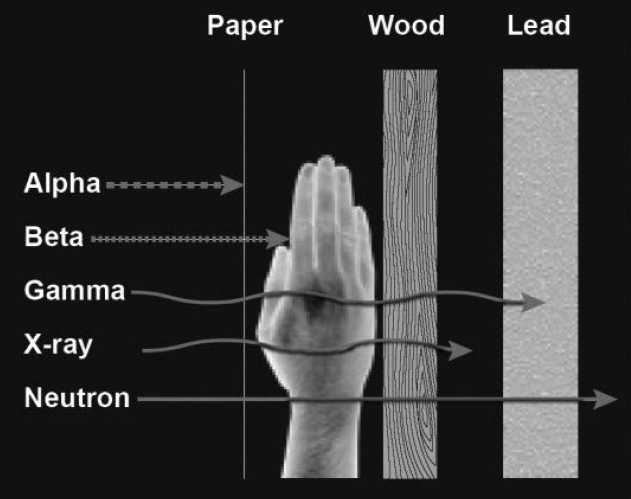
appropriate shielding can prevent the passage of different types of radiation
Source: Nuclear Regulatory Commission, Safety of Spent Fuel Storage (p.9)
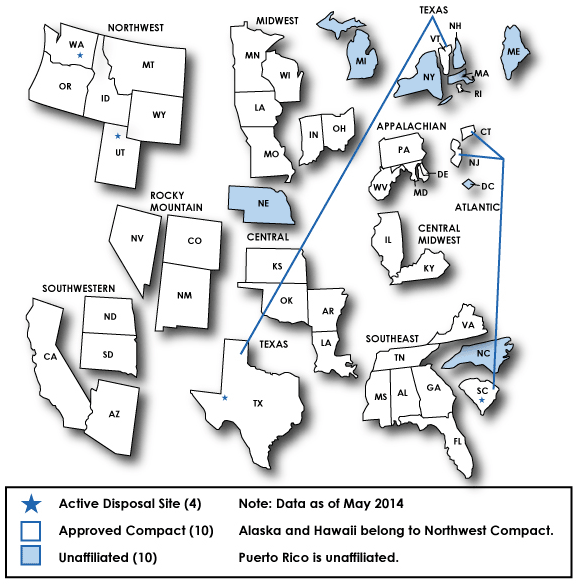
most states have chosen to join a compact for disposal of low-level radioactive waste, but some states are unaffiliated
Source: Nuclear Regulatory Commission, Low-Level Waste Compacts